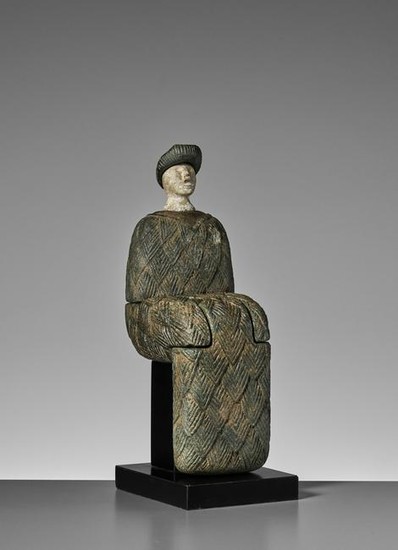A BACTRIAN COMPOSITE STONE SEATED FEMALE FIGURE
A BACTRIAN COMPOSITE STONE SEATED FEMALE FIGURE
Bactria-Margiana, circa late 3rd to early 2nd millennium BC. Composed of a dark gray chlorite body, the feet, lap and torso separately made, wearing a kaunakes, or tufted garment, indicated by incised and sculpted overlapping triangles, the collar plain, the neckline rounded in front and V-shaped in the back, the white stucco head set into a recess on its flaring neck, the oval face with a prominent nose and recessed eyes, her separately-made hair of chlorite as well, arranged in a layered coiffure.
Provenance: Arthur Huc (1854-1932). Marcel Huc, inherited from the above. Thence by descent within the same family. Arthur Huc was the chief editor of La Depêche du Midi, at the time the leading newspaper in Toulouse, France. He was also an accomplished art critic and early patron of several artists, including Henri de Toulouse-Lautrec. At the same time, Arthur Huc was a keen collector of Asian art, a passion that he inherited from his legendary ancestor Evariste Regis Huc, also known as the Abbe Huc (1813-1860), a French Catholic priest and traveler who became famous for his accounts of Qingera China, Mongolia and especially the then-almost-unknown Tibet in his book "Remembrances of a Journey in Tartary, Tibet, and China".
Condition: Strong wear and weathering, encrustations, some losses, one hole drilled to one segment. The stucco head shows stronger wear than the stone segments. Overall still excellent condition considering the age of this lot.
Weight: 3.1 kg including base
Dimensions: Height 26.5 cm (without base) and 28.5 cm (with base)
Small statuettes like the present lot have been produced by the Oxus civilization, which existed between 2300 and 1700 BC in Central Asia. This culture produced the rather distinct type of female statuary also known as 'Bactrian Princesses'. Most of them are seated composite figures. As the Oxus civilization, due to its strategic position in Central Asia, had intense links with neighboring cultures, these small figures also reveal a certain Mesopotamian influence. Despite their name, the 'Bactrian Princesses' are nowadays believed to be depictions of female deities who played a regulatory role in the natural order, pacifying the untamed forces embodied by lions, snakes, or dragons, rather than being portraits of members of the noble elite.
With an associated modern base. (6)
Literature comparison: For a similar seated female figure also wearing a tufted garment, see pls. 114-115 in Ligabue and Salvatori, eds., Bactria, an Ancient Oasis Civilization from the Sands of Afghanistan. The authors postulate (p. 177, op. cit.) that the horizontal lap of these figures may have served as an offering table.
Auction result comparison: For a related statue see Christie's New York in Antiquities, 9 June 2011, lot 19, sold for USD $68,500.
Sale price
Estimate
Time, Location
Auction House
A BACTRIAN COMPOSITE STONE SEATED FEMALE FIGURE
Bactria-Margiana, circa late 3rd to early 2nd millennium BC. Composed of a dark gray chlorite body, the feet, lap and torso separately made, wearing a kaunakes, or tufted garment, indicated by incised and sculpted overlapping triangles, the collar plain, the neckline rounded in front and V-shaped in the back, the white stucco head set into a recess on its flaring neck, the oval face with a prominent nose and recessed eyes, her separately-made hair of chlorite as well, arranged in a layered coiffure.
Provenance: Arthur Huc (1854-1932). Marcel Huc, inherited from the above. Thence by descent within the same family. Arthur Huc was the chief editor of La Depêche du Midi, at the time the leading newspaper in Toulouse, France. He was also an accomplished art critic and early patron of several artists, including Henri de Toulouse-Lautrec. At the same time, Arthur Huc was a keen collector of Asian art, a passion that he inherited from his legendary ancestor Evariste Regis Huc, also known as the Abbe Huc (1813-1860), a French Catholic priest and traveler who became famous for his accounts of Qingera China, Mongolia and especially the then-almost-unknown Tibet in his book "Remembrances of a Journey in Tartary, Tibet, and China".
Condition: Strong wear and weathering, encrustations, some losses, one hole drilled to one segment. The stucco head shows stronger wear than the stone segments. Overall still excellent condition considering the age of this lot.
Weight: 3.1 kg including base
Dimensions: Height 26.5 cm (without base) and 28.5 cm (with base)
Small statuettes like the present lot have been produced by the Oxus civilization, which existed between 2300 and 1700 BC in Central Asia. This culture produced the rather distinct type of female statuary also known as 'Bactrian Princesses'. Most of them are seated composite figures. As the Oxus civilization, due to its strategic position in Central Asia, had intense links with neighboring cultures, these small figures also reveal a certain Mesopotamian influence. Despite their name, the 'Bactrian Princesses' are nowadays believed to be depictions of female deities who played a regulatory role in the natural order, pacifying the untamed forces embodied by lions, snakes, or dragons, rather than being portraits of members of the noble elite.
With an associated modern base. (6)
Literature comparison: For a similar seated female figure also wearing a tufted garment, see pls. 114-115 in Ligabue and Salvatori, eds., Bactria, an Ancient Oasis Civilization from the Sands of Afghanistan. The authors postulate (p. 177, op. cit.) that the horizontal lap of these figures may have served as an offering table.
Auction result comparison: For a related statue see Christie's New York in Antiquities, 9 June 2011, lot 19, sold for USD $68,500.



